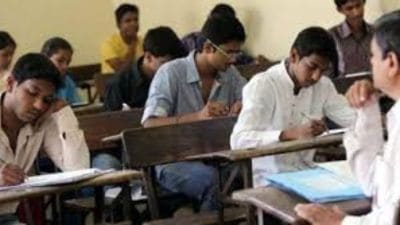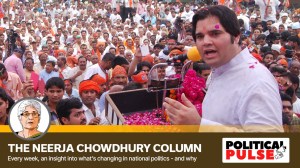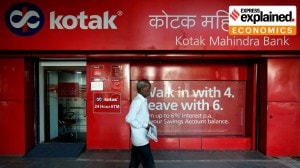- India
- International
Recent events are beginning to challenge the narrative of a Rising India
Rising India narrative is suffering due to re-hyphenation with Pakistan, slowing growth, retreat from RCEP, Trumpism.
 The turn of the century was when a new narrative about independent India began to strike root globally.(Illustration by C R Sasikumar)
The turn of the century was when a new narrative about independent India began to strike root globally.(Illustration by C R Sasikumar)
Three developments defined the narrative of “Rising India” over the past quarter century. First, India’s economic rise; second, as a consequence of that rise, India’s globalisation and integration into a “Rising Asia”; and third, a growing recognition that India was liberating itself from the historical baggage of its neighbourhood. Events in the recent past have cast a shadow on each of these elements and are beginning to question, if not yet challenge, the narrative of a Rising India.
The turn of the century was when a new narrative about independent India began to strike root globally. India had not only come out of a serious economic crisis, in 1991-92, but had landed on its feet in the new post-Cold War world, switching sides from an imploding Soviet Union and building bridges with a rising Asia. Prime Minister PV Narasimha Rao’s sagacious leadership of major economic and foreign policy changes helped improve the performance of the economy and raised India’s global profile. Improved government finances and a growing confidence in the Indian economy allowed Prime Minister Atal Bihari Vajpayee to declare India a nuclear weapons power. Thanks to the economy’s new robustness, India overcame the impact of the economic sanctions imposed by the United States, Japan and several European nations in response to the nuclear tests of 1998.
Trade liberalisation, industrial delicensing and decontrol and fiscal stabilisation contributed to an increase in the share of foreign trade and manufacturing output in national income, rather than hurt growth. This boosted investor confidence in the economy’s growth poteSanjaya Baruntial. New firms began to come up and so did new industries. Years of quiet investment in the teaching of computer sciences had created an army of technicians that the world needed in making the transition from the 20th century to the 21st. It was called the Y2K problem and Indians were equipped to solve it. The internet was entering homes and an Indian called Sabeer Bhatia had invented Hotmail.com and allowed the worldwide Indian diaspora to re-connect and mobilise. Indian companies were quoting on the New York stock exchange and new sectors of a protected economy were opening up.
Taken together, all these factors made American strategic analyst, Condoleezza Rice, later to become President George W Bush Jr’s secretary of state, write an essay in the highly regarded journal, Foreign Affairs, in early 2000, urging the US political leadership not to think of India as a neighbour of Pakistan but as a neighbour of China. While China would emerge as a “strategic competitor”, said Rice, India could be the US’s “strategic partner”. While President Bill Clinton gave China an easy entry into the World Trade Organisation in 2000, President Bush decided to get tough and, as he told this writer once, he chose “to break a lot of China (sic) to make sure India got the nuke deal.”
Two unrelated developments around that time also contributed to the positive narrative about India. First, the manner in which India responded to Pakistan’s incursions into Kashmir, near Kargil, and the fact that terrorists attacking the US in September 2001 had a Pakistan connection. By 2005, when President Bush spent five days in India and five hours in Pakistan, the “de-hyphenation” of the South Asian adversaries had been completed.

Consider the events of the more recent past. For months on end in the run-up to the 2019 Lok Sabha elections, terrorism and Pakistan were on prime time news every single day. While the last major terror attack in India staged by Pakistan was in November 2008, the attacks across the border at Uri and Pathankot became the focal points of a sustained political campaign. Keeping terrorism in the news even when terrorist attacks are down has proved counter-productive and contributed to the re-hyphenation with Pakistan. This was only further facilitated by the decision to repeal Article 370 of the Constitution and alter the status of Jammu and Kashmir.
This in itself could have been managed if the Indian economy had been chugging along, but that was not to be. The slowing down of the economy, be it cyclical or structural, has been compounded by confused handling and mixed signals. Investors remain risk averse and consumers remain bearish, despite bold policy moves. The widely welcomed fiscal reform has had the adverse effect of reducing the government’s fiscal space, further choking off investment even in infrastructure.
Against this background, the prime minister’s decision to retreat from the Asian Regional Comprehensive Economic Partnership (RCEP) negotiations has added to a sense of siege. If India delinks itself from the Rising Asia train, would its own Rising India strategy not get derailed? Questions are beginning to be raised not just about India’s growth potential and the government’s fiscal capacity but also the competitiveness of the agricultural, manufacturing and even services sectors.
In the quarter century from 1991 to 2016, the US emerged as a strategic partner willing to aid India’s rise. In the three years since President Donald Trump came to office, the US has signaled a change of gears, if not a change of course. While he has launched a strategy for the geo-economic containment of China, he has not taken his eye off India’s trade policies nor has he been re-assuring on all of India’s security concerns, with Pakistan regaining diplomatic ground lost in the aftermath of 9/11. On top of it all, global economic growth does not as yet offer much hope for India. One silver lining remains in subdued energy prices that would offer the government much needed fiscal relief.
Taken together, domestic economic management, recent political and geopolitical choices made at home, the regional and global consequences of Trump and Trumpism, the geo-economics and geo-politics of China’s rise, are all beginning to pose a challenge to the extant Rising India narrative. The old narrative is taking a beating. A new narrative can only be built on the foundations of improved economic performance and better management of domestic political challenges. A return to the earlier growth path is predicated upon altering recent perceptions about India’s economic prospects and policies, the political choices made and geopolitical options explored.
This article first appeared in the print edition on November 15, 2019 under the title ‘India needs a new story’. The writer is Distinguished Fellow, Institute for Defence Studies & Analysis, New Delhi.
EXPRESS OPINION
Apr 24: Latest News
- 01
- 02
- 03
- 04
- 05










































